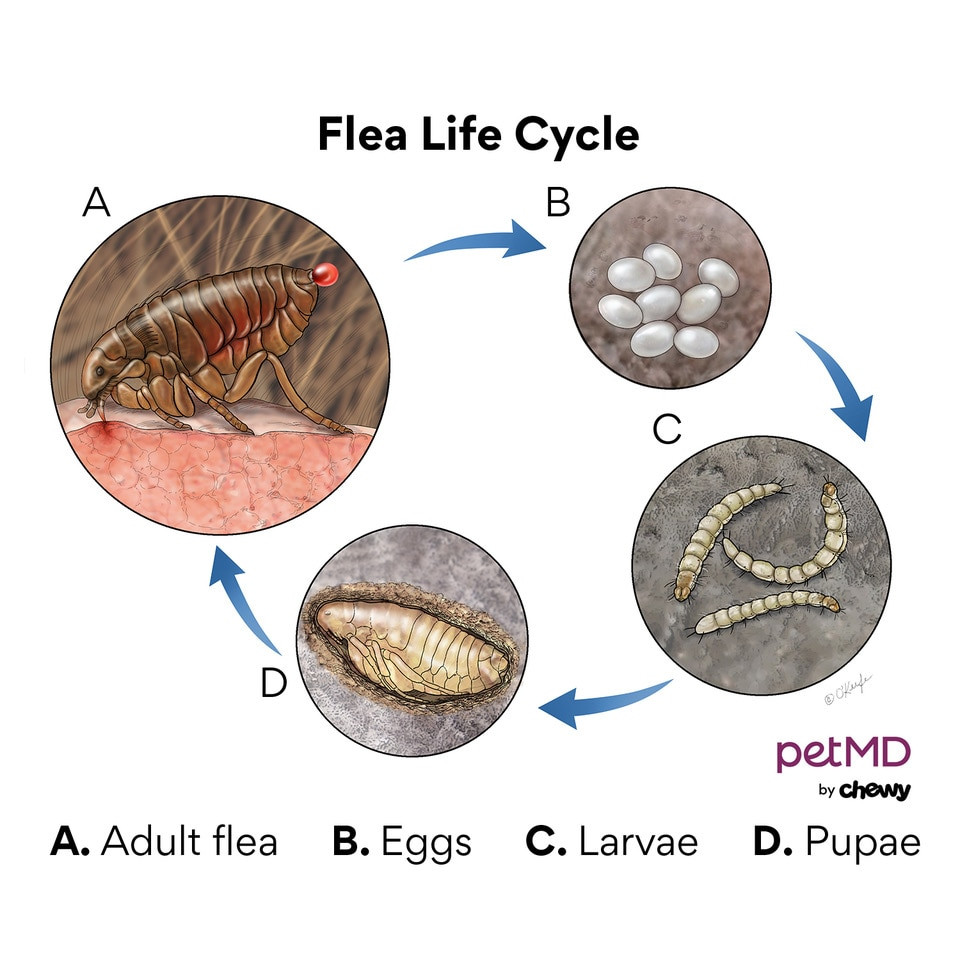Discovering fleas on your beloved pet or in your home can be unsettling. These tiny, dark insects, often seen scurrying through your pet’s fur or leaving itchy red bumps on your skin, are more than just a nuisance. They are parasites that feed on blood and can transmit diseases. Understanding where fleas originate is the first step in effectively preventing and managing infestations.
Understanding Fleas and Their Origins
Fleas are small but resilient parasites, typically about 1/8 inch in size, that survive by feeding on the blood of mammals, including dogs, cats, and humans. While some flea species prefer birds, they generally don’t pose a threat to household pets. The flea life cycle is complex, consisting of four distinct stages: egg, larva, pupa (within a cocoon), and adult.
Fleas thrive in warm conditions, making them more prevalent during the warmer months. However, they can survive year-round indoors, especially in heated homes. While they are a constant pest in warmer climates, they can also be found seasonally in colder regions. Temperature is a key factor in their life cycle; in cold weather, it can take over 200 days for a flea to mature from egg to adult. In contrast, this cycle is significantly faster in summer, potentially taking just two to three months with proper treatment.
 Flea life cycle diagram illustrating the four stages: egg, larva, pupa, and adult, crucial for understanding flea origins and control.
Flea life cycle diagram illustrating the four stages: egg, larva, pupa, and adult, crucial for understanding flea origins and control.
Common Sources of Fleas for Dogs and Homes
Many pet owners wonder, “Where Do Fleas Come From?”. Dogs can pick up fleas in various ways, often from environments or other animals that harbor these parasites. Understanding these sources is crucial for prevention.
Contact with Infested Animals
Direct contact with other flea-infested animals is a primary way dogs get fleas. This can happen in various settings:
- Dog Parks and Walks: Interactions with other dogs during walks or at dog parks can easily lead to flea transmission if one of the dogs is infested.
- Playdates and Kennels: Playdates at other homes or stays in kennels are also potential flea hotspots. Even a brief encounter can be enough for fleas to jump from one host to another.
- Visiting Pets: Friends or visitors with pets might unknowingly bring fleas into your home, which can then transfer to your dog.
Wildlife in Your Yard
Wildlife around your home can also be a significant source of fleas. Animals like raccoons, foxes, squirrels, and rodents can carry fleas and introduce them to your yard.
- Backyard Grass: When these wild animals roam through your yard, they can drop fleas and flea eggs into the grass. These fleas can then jump onto your dog when it’s playing or simply walking in the yard.
- Unseen Carriers: Wildlife often goes unnoticed, making it a silent source of flea infestations.
Infested Environments
Fleas don’t just live on animals; they can also survive in various environments, waiting for a host.
- Grass and Outdoor Areas: Flea eggs and larvae can thrive in shaded, humid outdoor areas like grass, leaf piles, and under bushes.
- Carpets and Upholstery: Indoors, flea eggs can fall off pets and hatch in carpets, rugs, and upholstery, creating a continuous cycle of infestation.
- New Places: Visiting new environments like campgrounds or other people’s homes, especially with pets, can expose your dog to fleas present in those locations.
Hitchhiking Fleas
Fleas are adept hitchhikers and can enter your home in unexpected ways.
- On Clothes and Shoes: Fleas can jump onto your socks, pant legs, or shoes when you walk through infested areas outdoors and be carried inside.
- Jumping Indoors: While less common, fleas can even jump through screened windows or doors if they are close enough to an infested area outside.
Debunking Myths About Flea Origins
It’s important to dispel some common misconceptions about where fleas come from. Fleas do not spontaneously appear; they always come from an existing flea population. Understanding this helps in targeting prevention efforts effectively. Fleas are brought into your environment, usually by animals carrying them.
Preventing Flea Infestations
Preventing fleas is significantly easier than getting rid of an infestation. Year-round flea prevention is crucial for most pets, especially in areas with mild winters.
- Flea Preventative Medications: Using veterinarian-recommended flea prevention products is the most effective way to protect your dog. These come in various forms, including topical treatments and oral medications.
- Regular Home Cleaning: Frequent vacuuming of carpets, rugs, and floors helps remove flea eggs, larvae, and pupae from your home environment. Washing pet bedding regularly in hot water is also essential.
- Yard Maintenance: Keeping your yard tidy, cutting grass short, and removing leaf piles can reduce flea habitats in your outdoor spaces.
- Limit Contact with Unknown Animals: While socialization is important, be mindful of your dog’s interactions with unknown animals, especially in areas known to have fleas.
Conclusion
Understanding “where do fleas come from” is vital for effective flea control and prevention. Fleas originate from existing flea populations and are typically brought into your pet’s environment through contact with infested animals or environments. By understanding these common sources and implementing preventative measures, you can protect your dog and home from flea infestations, ensuring a healthier and more comfortable environment for everyone. Regular flea prevention, combined with good hygiene practices for both your pet and home, is the best strategy for keeping these pesky parasites at bay.

